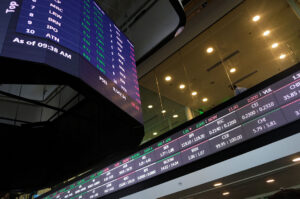By Luisa Maria Jacinta C. Jocson, Reporter
NET INFLOWS of foreign direct investments (FDI) fell to their lowest level in over four years in September, data from the Bangko Sentral ng Pilipinas (BSP) showed.
The central bank on Tuesday reported FDI net inflows slumped by 36.2% to $368 million in September from $577 million in the same month a year ago.
This was also the lowest monthly FDI inflow in 53 months or since the $314 million recorded in April 2020. To recall, strict lockdowns to curb the spread of the coronavirus disease 2019 (COVID-19) were in effect in April 2020.
Month on month, net inflows likewise plunged by 54.8% from $815 million.
“The downturn in FDI net inflows in September 2024 was due largely to the decline in nonresidents’ net investments in debt instruments,” the BSP said.
Nonresidents’ net investments in debt instruments of local affiliates dropped by 32.8% to $277 million in September from $413 million a year prior.
Net investments in equity capital other than reinvestment of earnings plummeted by 91.2% to $7 million in September from $83 million a year earlier.
Equity capital placements slid by 53.4% year on year to $82 million, while withdrawals dropped by 19.7% to $75 million.
By source, equity placements were mainly from Japan (60%), followed by the United States (25%), and Singapore (8%).
These were invested mostly in manufacturing (58%), real estate (19%), information and communication (8%), and wholesale and retail trade (5%).
Meanwhile, investments in equity and investment fund shares stood at $91 million in September, down by 44.6% from $164 million a year ago.
On the other hand, reinvestment of earnings went up by 3.6% to $84 million in September from $81 million last year.
NINE-MONTH FDIFor the first nine months of the year, FDI net inflows rose by 3.8% to $6.66 billion from $6.42 billion in the similar period a year ago.
Investments in equity and investment fund shares jumped by 20.4% to $2.3 billion in the period ending September from $1.91 billion a year ago.
Net foreign investments in equity capital surged by 46.9% to $1.36 billion as of end-September from $923 million a year ago.
This as equity capital placements climbed by 28.1% to $1.79 billion, while withdrawals dipped by 8.5% to $434 million.
In the nine-month period, these placements mostly came from the United Kingdom (43%), Japan (37%), the United States (9%), and Singapore (4%).
Meanwhile, foreign investments in debt instruments decreased by 3.3% to $4.35 billion in the January-September period from $4.5 billion.
Reinvestment of earnings dipped by 4.2% to $949 million as of end-September from $991 million a year ago.
“The relatively lower FDI inflows could be largely brought about by a wait-and-see stance by some foreign investors while waiting for the CREATE MORE to be passed into law,” Rizal Commercial Banking Corp. Chief Economist Michael L. Ricafort said in a Viber message.
In November, President Ferdinand R. Marcos, Jr. signed the Corporate Recovery and Tax Incentives for Enterprises to Maximize Opportunities for Reinvigorating the Economy (CREATE MORE) Act, which expands fiscal incentives and lowers corporate income tax on certain foreign enterprises.
Mr. Ricafort also noted the “still relatively high” interest rates, which may have weighed on foreign investments.
The BSP embarked on its rate-cutting cycle in August this year with a 25-basis-point (bp) rate cut. It later delivered another 25-bp cut in October, bringing the key rate to 6%.
“Persistently high global interest rates, led by the US Fed have made emerging market investments like the Philippines less attractive,” John Paolo R. Rivera, a senior research fellow at the Philippine Institute for Development Studies, said.
“Investors often prefer safe-haven assets in advanced economies under these conditions,” he added.
The US Federal Reserve kicked off its easing cycle with a 50-bp cut in mid-September.
Mr. Rivera also noted “heightened geopolitical tensions and economic uncertainties may have also further dampened investor confidence globally.”
“Likewise, slowing economic growth could have raised concerns among foreign investors. Economic growth was slightly weaker than anticipated in the third quarter of 2024, which may have influenced investment sentiment,” he added.
The Philippine economy grew by weaker-than-expected 5.2% in the July-to-September period, its slowest growth in five quarters or since the 4.3% expansion in the second quarter of 2023.
“For the coming months, the CREATE MORE law would now make international investors more decisive to locate in the country with better incentives that could compete better with other Asian countries,” Mr. Ricafort said.
Further rate cuts by the BSP and Fed would also increase demand for loans and attract more FDIs moving forward, he added.
The Monetary Board is set to have its final policy review on Dec. 19. BSP Governor Eli M. Remolona, Jr. has signaled the possibility of reducing or keeping rates steady.
Meanwhile, Reuters reported that traders are pricing in an 86% chance of another quarter-percentage-point rate cut from the Fed at its Dec. 17-18 meeting.
On the other hand, Mr. Ricafort flagged US President-elect Donald J. Trump’s protectionist trade policies.
“More protectionist policies by a Trump presidency starting in 2025 would discourage some US companies from investing and creating more jobs outside the US, as well as a potential trade war between the US and China or other countries that could slow down the world economy and global trade,” he added.
Mr. Trump has pledged to slap an additional 10% tariff on Chinese goods in a bid to force Beijing to do more to stop the trafficking of chemicals used to make fentanyl, Reuters reported.
Mr. Trump has previously said he would introduce tariffs in excess of 60% on Chinese goods.
The BSP expects to record FDI net inflows of $10 billion this year.






